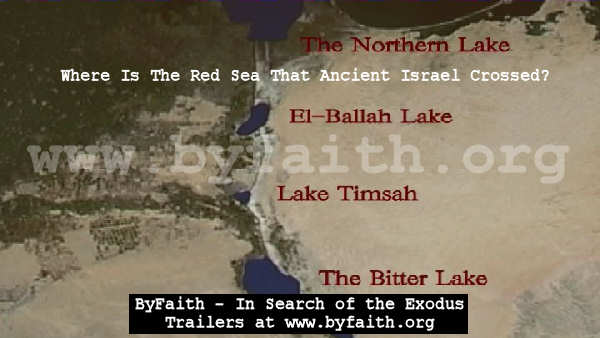
|
|
The Red Sea
What was the Red Sea and where is the Red Sea that ancient Israel crossed?
The parting of the Red Sea is central to the Exodus story, but no-one has proved conclusively where the crossing took place. We know that the
starting point for the Exodus was the area of Ramesses, and one traditional idea is that the Hebrews headed south and crossed the tip of the Red Sea.
Another theory is that ancient Israel crossed over the Gulf of Aqaba.
In the Hebrew text, the body of water that the Hebrews crossed is literally called "Yam-Suph." This was translated as the Red Sea, but many believe its true meaning was always “Sea of Reeds." The Sea of Reeds interpretation of the Bible opens up new possibilities and gives us four more options for the crossing – the Northern lake, the El-Ballah Lake, Lake Timsah, or the Bitter Lake. Many have tried to use the details that the Bible gives us to identify locations where the Hebrews travelled, but none have been able to present a credible scenario that can be tested, tried and be accepted by the body of opinion. Therefore, trying to find ‘the exact’ location of the crossing, without any reliable ancient inscriptions is at present impossible. However, the Bible does indicate that Mount Sinai is in the Sinai Peninsula and because most scholars now believe the “Sea of Reeds” interpretation of the Red Sea is most accurate, one of the lake crossings is most likely. 'Then Moses let his father-in-law depart (from Mt. Sinai) to his own land (Midian)’ Exodus 18:27. Midian is found in today's Saudi Arabia, therefore the Bible indicates that Mount Sinai must be in the Sinai Peninsula and the Red Sea crossing point before the Sinai Peninsula. ‘Israel in Egypt - The Exodus Mystery DVD’ Enter ancient Egypt and search for the evidence for the Bible's Exodus. Go. ‘The Exodus Evidence Book’ Experience a photographic search for the Bible’s Exodus. 100+ colour photos. Go. |
More From ByFaith Ancient Egypt Go The economy Go The face of Joseph Go Why can't I sleep? Go Christian or disciple? Go In pursuit of purpose Go 150 Years of Revival Go What is my worldview? Go Understanding revival Go Where was the Red Sea? Go The battle of the mind Go Forgiveness and justice Go Great revivals in Korea! Go Economise to evangelise Go How can we see revival? Go Great Christian Revivals Go I want to be a missionary! Go Three simple godly habits Go What really is repentance? Go The Hebrew Slaves In Egypt Go Who was the Exodus Pharaoh? Go Revival Fires and Awakenings Go Discover a greater anointing Go Mission Preparation Training Go What's wrong with witchcraft? Go Ancient Israel found in Egypt Go The face of the Exodus Pharaoh Go I need £500 for a mission trip Go Is Mount Sinai in Saudi Arabia? Go Revival and the Great Commission Go The Cross and the Blood of Jesus Go The lost years of Moses in Egypt Go Christian charity and abuse of it Go The spirit of fear and intimidation Go One thing I have desired of the Lord Go The priesthood, the urim and thummim Go Should Christians date non-Christians? Go Why should I keep re-reading the Bible? Go Is there evidence for Joseph in Egypt? Go |

|

